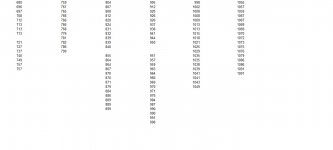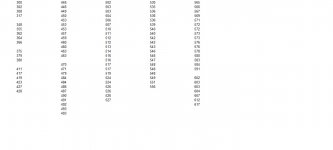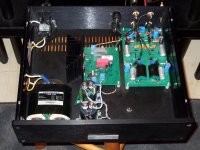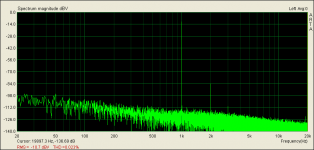4.7uF only. Sorry no play there. Its calculated in the OLG response shape. If you want to try bigger value, only 22uF/50V electrolytic non low ESR as suggested in the guide.
Thanks Salas.
Hi Salas,
Can't find 2SK117 from 4-5mA.
I measured all 2SK117 received from GB and they all circa from 5.27 to 5.82 mA.
So, I choose closed matched pairs and doped them into Q 2,3,5.
Luckily, I found 4.29/4.31 pair in my own stock and used these for Q7.
R3x and R6x changed per manual to 6.2K and 33R.
Is it OK?
Can't find 2SK117 from 4-5mA.
I measured all 2SK117 received from GB and they all circa from 5.27 to 5.82 mA.
So, I choose closed matched pairs and doped them into Q 2,3,5.
Luckily, I found 4.29/4.31 pair in my own stock and used these for Q7.
R3x and R6x changed per manual to 6.2K and 33R.
Is it OK?
Last edited:
Q7 is not much critical for scale, rather more for fair matching, its OK that you kept it there. You did well you kept them alike in the regs. Your R3X and R6X choices are adequate for strong K117GR.
Hi Salas.
How important is it to use the heathsink proposed in the BOM? Now I have a bunch of sinks a bit higher than the proposed ones but they will fit. I have no clue of their efficiency though... A rough guess is 5-C/W'ish based on comparing the looks of them against other types. I reckon I'll have to test and monitor the temperature. When you say one of the regs gets quite hot - how hot is that in centigrades?
Regards
How important is it to use the heathsink proposed in the BOM? Now I have a bunch of sinks a bit higher than the proposed ones but they will fit. I have no clue of their efficiency though... A rough guess is 5-C/W'ish based on comparing the looks of them against other types. I reckon I'll have to test and monitor the temperature. When you say one of the regs gets quite hot - how hot is that in centigrades?
Regards
Q7 is not much critical for scale, rather more for fair matching, its OK that you kept it there. You did well you kept them alike in the regs. Your R3X and R6X choices are adequate for strong K117GR.
🙂.
Thank you.
Hi Salas.
How important is it to use the heathsink proposed in the BOM? Now I have a bunch of sinks a bit higher than the proposed ones but they will fit. I have no clue of their efficiency though... A rough guess is 5-C/W'ish based on comparing the looks of them against other types. I reckon I'll have to test and monitor the temperature. When you say one of the regs gets quite hot - how hot is that in centigrades?
Regards
5C/W sounds good. In general, if you will not climb more than 25C above ambient on the Q6x's sink you are in spec.
Matching done Phuu.. 225 in total
2SK170BL from from old stock (Mouser 16 ea) and 100ea from Schuro-Elektronik
2SK117GR from Simplistic GB and old stock (BIB GB)
measures quite good, pairs is no probl to make quads is not so easy, (its possible though)
results for 2SK170 to the left all batched in groups by 5%
2SK170BL from from old stock (Mouser 16 ea) and 100ea from Schuro-Elektronik
2SK117GR from Simplistic GB and old stock (BIB GB)
measures quite good, pairs is no probl to make quads is not so easy, (its possible though)
results for 2SK170 to the left all batched in groups by 5%
Attachments
Last edited:
I believe that matching using IDSS only works within the same "batch".
Depends on Vgs (off) correlation for matching gain if different enough but normally it does not vary too much between batches so to give hassle after degeneration as I have seen on the curve tracer. There is always R8 to trim if in a situation of no close enough 2nd stage jfets. It takes some careful measurements of course.
P.S. The lower the overall gain setting the less any gain matching difficulty will manifest BTW.
Why you would want K170 quads for this circuit?
no you are right, i dont need quads for the folded ,
its just to let you get an idea of how far apart this lot is,
The 117 though are now ready matched to go in the BIB,
it takes quite some 117 to fill up a dual mono dual voltage BIB reg assembly
Example:
In this one when using good idss matches with no other parameters noted, I got 63dB dead on for both channels with 48R and 48.5R Rs via trimmers on the K170 second stages. I.e. no significant compensation for same Rdrain voltage drop. This older p2p proto has 3 K369 and just 12 Ohm enR when cold or ~0.45nVSQrtHz of input noise. You can see a V1.2R regulator at 250mA also. When I averaged it for 131072 FFT it gave -105dBV at 20Hz noise floor. Plays for a VDH Colibri gold coils type on another system.
In this one when using good idss matches with no other parameters noted, I got 63dB dead on for both channels with 48R and 48.5R Rs via trimmers on the K170 second stages. I.e. no significant compensation for same Rdrain voltage drop. This older p2p proto has 3 K369 and just 12 Ohm enR when cold or ~0.45nVSQrtHz of input noise. You can see a V1.2R regulator at 250mA also. When I averaged it for 131072 FFT it gave -105dBV at 20Hz noise floor. Plays for a VDH Colibri gold coils type on another system.
Attachments
Hi Salas,
1. What is the approximate gain of the first stage (Q1, Q2, Q3)?
2. What is the expected voltage on Q3 collector (TP2, or Q3, R4, R14) when the voltage between TP1 and TP2 is set to 3.6 Volt?
3. Do you have SNR measurements, even approximate, or simulated, for the entire folded simplistic and possibly also for the first stage (Q1, Q2, Q3) in itself?
1. What is the approximate gain of the first stage (Q1, Q2, Q3)?
2. What is the expected voltage on Q3 collector (TP2, or Q3, R4, R14) when the voltage between TP1 and TP2 is set to 3.6 Volt?
3. Do you have SNR measurements, even approximate, or simulated, for the entire folded simplistic and possibly also for the first stage (Q1, Q2, Q3) in itself?
1. About 45dB in the 63dB highest sensitivity on the PCB version
2. 4-4.2V in respect to ground
3. I have overall FFT for the 63dB highest sensitivity on the PCB version that I had posted once before. Non weighed, non averaged 65536 FFT.
So, this one has all the audio band for you to correlate any portion.
2. 4-4.2V in respect to ground
3. I have overall FFT for the 63dB highest sensitivity on the PCB version that I had posted once before. Non weighed, non averaged 65536 FFT.
So, this one has all the audio band for you to correlate any portion.
Attachments
Now, that is a beefy Tx. And I see a line in AC filter additionaly.
Its just what I had in my drawers at that time.😀
Hi Salas,
Thank you.
So, as I understand, the first stage's gain can be adjusted between about 20 or 22dB and 45dB. Is that correct?
Thank you.
So, as I understand, the first stage's gain can be adjusted between about 20 or 22dB and 45dB. Is that correct?
- Home
- Source & Line
- Analogue Source
- Simplistic NJFET RIAA



